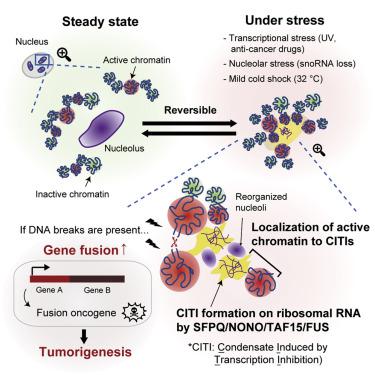Molecular Cell ( IF 14.5 ) Pub Date : 2022-06-02 , DOI: 10.1016/j.molcel.2022.05.010 Takaaki Yasuhara 1 , Yu-Hang Xing 2 , Nicholas C Bauer 3 , Lukuo Lee 2 , Rui Dong 2 , Tribhuwan Yadav 4 , Roy J Soberman 3 , Miguel N Rivera 5 , Lee Zou 2

|
The proper function of the genome relies on spatial organization of DNA, RNA, and proteins, but how transcription contributes to the organization is unclear. Here, we show that condensates induced by transcription inhibition (CITIs) drastically alter genome spatial organization. CITIs are formed by SFPQ, NONO, FUS, and TAF15 in nucleoli upon inhibition of RNA polymerase II (RNAPII). Mechanistically, RNAPII inhibition perturbs ribosomal RNA (rRNA) processing, releases rRNA-processing factors from nucleoli, and enables SFPQ to bind rRNA. While accumulating in CITIs, SFPQ/TAF15 remain associated with active genes and tether active chromatin to nucleoli. In the presence of DNA double-strand breaks (DSBs), the altered chromatin compartmentalization induced by RNAPII inhibition increases gene fusions in CITIs and stimulates the formation of fusion oncogenes. Thus, proper RNAPII transcription and rRNA processing prevent the altered compartmentalization of active chromatin in CITIs, suppressing the generation of gene fusions from DSBs.
中文翻译:

转录抑制诱导的冷凝物将活性染色质定位于核仁
基因组的正常功能依赖于 DNA、RNA 和蛋白质的空间组织,但转录如何对组织做出贡献尚不清楚。在这里,我们证明转录抑制(CITI)诱导的凝聚物极大地改变了基因组空间组织。CITI 是由核仁中的 SFPQ、NONO、FUS 和 TAF15 在抑制 RNA 聚合酶 II (RNAPII) 后形成的。从机制上讲,RNAPII 抑制会扰乱核糖体 RNA (rRNA) 加工,从核仁中释放 rRNA 加工因子,并使 SFPQ 能够结合 rRNA。在 CITI 中积累的同时,SFPQ/TAF15 仍然与活性基因相关,并将活性染色质束缚在核仁上。在 DNA 双链断裂 (DSB) 存在的情况下,RNAPII 抑制引起的染色质区室化改变会增加 CITI 中的基因融合,并刺激融合癌基因的形成。因此,适当的 RNAPII 转录和 rRNA 加工可以防止 CITI 中活性染色质的区室化改变,从而抑制 DSB 基因融合的产生。











































 京公网安备 11010802027423号
京公网安备 11010802027423号